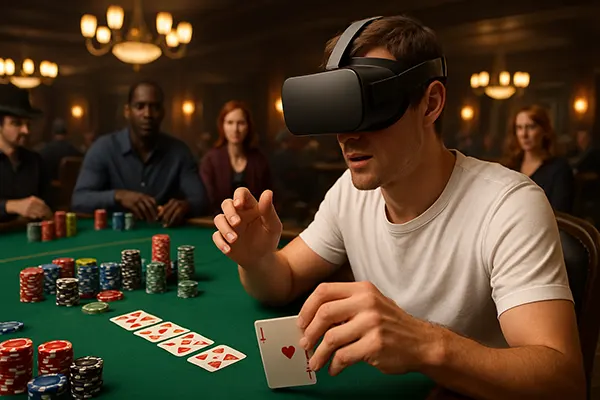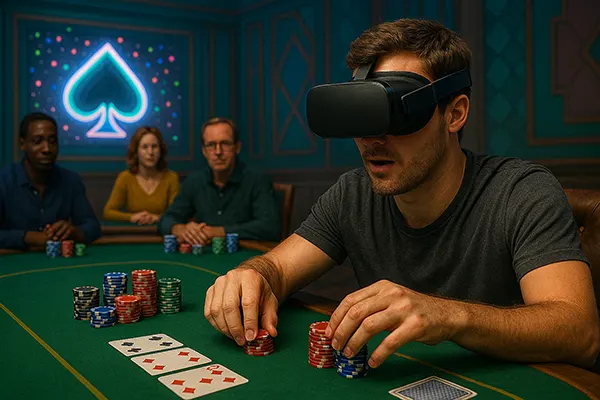
Poker in Virtual Reality: A New Dimension of Play
Virtual reality (VR) has steadily reshaped various industries, and the poker sector is no exception. In 2025, VR poker is no longer an experimental trend but a growing reality that merges traditional gameplay with immersive technology. Players can now enjoy authentic casino atmospheres, interact with opponents in real time, and experience a setting that closely mirrors face-to-face games. This transformation brings both opportunities and challenges, redefining what poker means in the digital age.
The Evolution of VR Poker
The journey of VR poker began with simple simulations, limited graphics, and restricted interactivity. Over the years, advancements in VR hardware and software have created a more realistic environment where players can see avatars, read subtle gestures, and engage in lifelike interactions. By 2025, leading technology companies and online gaming operators have invested significantly in developing fully immersive poker rooms accessible worldwide.
Improved processing power and faster internet speeds have made VR poker more stable and accessible. Headsets are lighter, more affordable, and easier to use, opening the door to a wider audience. The integration of spatial audio and 3D visual elements allows participants to feel as though they are physically present at the table, blurring the line between virtual and physical gameplay.
This evolution is not only technological but also cultural. Communities are forming within VR poker spaces, where players build friendships, share strategies, and establish competitive leagues. These communities enhance the social aspect of poker, which has always been central to the game’s appeal.
Advantages of Playing Poker in VR
One of the key advantages of VR poker is immersion. Traditional online poker often lacks the human touch, but VR technology allows participants to pick up on gestures, betting patterns, and even posture, providing a more authentic experience. This elevates the level of strategy, as players must adapt not only to cards but also to behavioural cues.
Another benefit lies in the social interaction. Players can chat, laugh, and celebrate victories with others, much like in physical casinos. This adds depth to the experience and makes it more than just a solitary game behind a screen. It restores the camaraderie and social tension that define traditional poker nights.
Finally, VR poker encourages inclusivity. Regardless of geographical location, anyone with the necessary equipment can join a virtual table. This accessibility bridges communities across continents, uniting players who may never have met otherwise and creating a truly global poker ecosystem.
Challenges and Limitations
Despite its promise, VR poker faces several challenges. The first is the financial barrier: while prices have dropped, VR headsets and compatible hardware are still costly for many potential players. This limits widespread adoption and keeps the technology largely in the hands of enthusiasts and early adopters.
Technical issues also remain. Lag, motion sickness, and compatibility problems can interfere with gameplay. While progress has been made in reducing these issues, they continue to be obstacles for consistent long-term play. Developers are working on refining user experience, but it is an ongoing process that requires investment and innovation.
Another challenge is regulatory oversight. As VR poker expands, gambling authorities worldwide must adapt rules to address fairness, security, and responsible gaming. Protecting users from fraud and ensuring that games remain transparent are priorities for regulators in 2025, as the industry seeks legitimacy and trust.
Security and Responsible Gaming in VR
Security is a critical concern in VR poker. Advanced encryption and identity verification systems are being implemented to safeguard transactions and prevent cheating. In virtual environments, developers must account for vulnerabilities that are different from traditional online poker rooms, making cybersecurity expertise essential.
Responsible gaming tools are also being adapted to VR. Time reminders, spending limits, and self-exclusion features are built directly into VR interfaces. These tools aim to balance entertainment with player protection, ensuring that immersive environments do not encourage excessive play.
Collaboration between regulators, operators, and technology providers is vital to create a safe framework for VR poker. With clear rules and transparent practices, the industry can grow while maintaining player confidence and trust.

The Future Outlook of VR Poker
The trajectory of VR poker suggests significant growth in the coming years. As hardware becomes more affordable and widely available, adoption rates are expected to rise. Analysts predict that VR poker will eventually be integrated into mainstream tournaments, allowing players to participate in global competitions from their living rooms.
Innovations such as artificial intelligence-driven dealers, haptic feedback, and enhanced 3D environments will further refine the experience. These features will make gameplay smoother and more interactive, potentially attracting a younger demographic familiar with gaming technologies.
Moreover, VR poker could influence the broader perception of poker itself. By making the game more accessible and engaging, it may inspire new audiences to explore poker not only as entertainment but also as a skill-based pursuit that blends psychology, mathematics, and strategy.
Global Integration and Player Communities
VR poker has the potential to foster international communities where players share not only the game but also cultural perspectives. This globalisation of poker may encourage new formats, collaborative events, and cross-border leagues, enriching the diversity of the game.
Educational opportunities are also emerging. Training platforms are integrating VR to teach poker skills in an interactive way, allowing learners to practise strategies in lifelike scenarios without financial risk. This could reshape how new players approach the game and lower the barrier to entry.
Ultimately, VR poker represents a new chapter in the history of the game. By blending tradition with cutting-edge technology, it opens the door to a fresh dimension of play, offering both seasoned players and newcomers a redefined way to connect, compete, and enjoy the timeless allure of poker.

